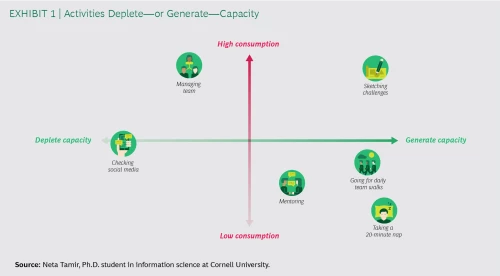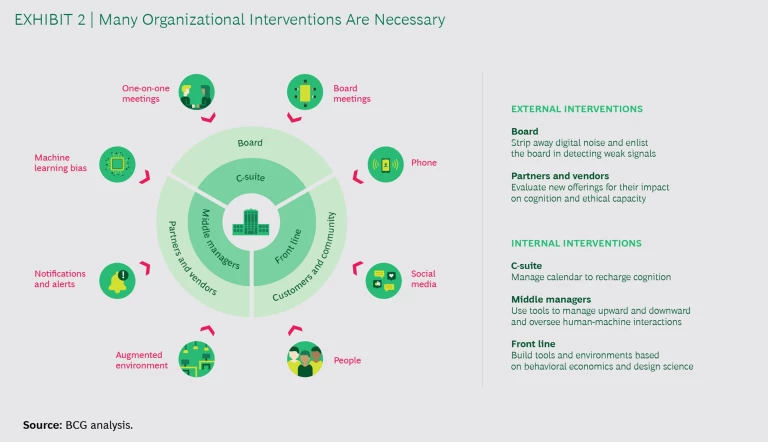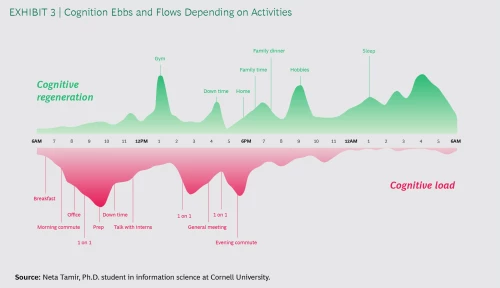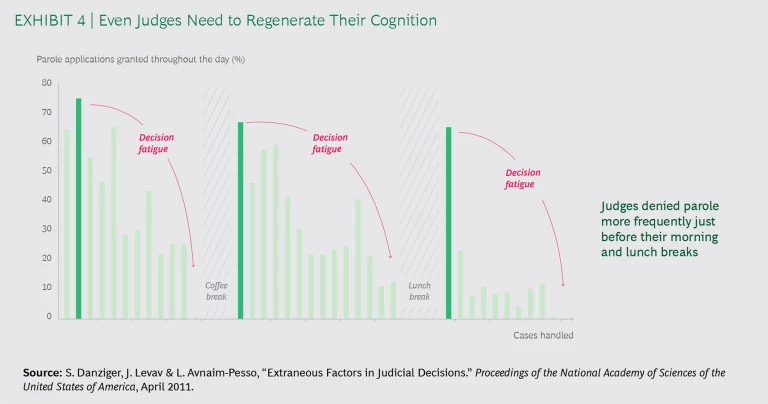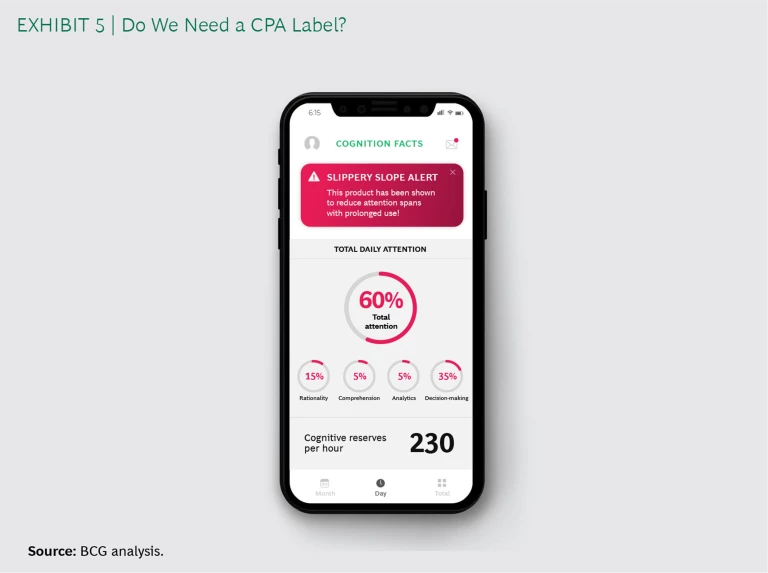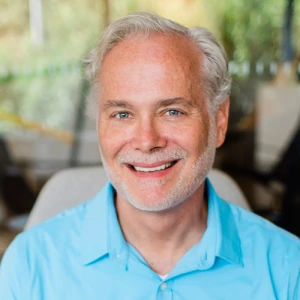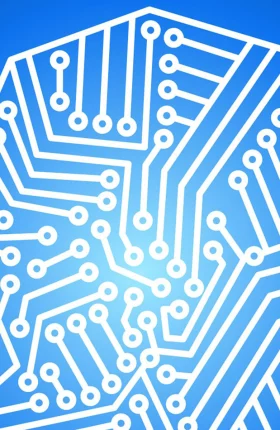We live in an era of cognitive overload. Smartphone notifications, social media chatter, and multitasking drain our attention. Some distracted people have addressed cognitive overload by turning their phone screens to grayscale ; others have used various tricks to break their phone addiction. Policymakers and regulators are considering ways to restrain the power of social media companies that reinforce or amplify cognitive biases in their quest for engagement and attention.
To date, most companies and large organizations have stayed out of this discussion. But the opportunity costs of remaining on the sideline are too high . Organizations must not only pay attention to this newest form of brain drain but also devise ways to protect, restore, and build the cognitive powers of their employees, partners, and customers.
The set of solutions will range from the straightforward to the futuristic. From the outset, the HR and IT functions must collaborate to create better organizational cognition practices. This goes far beyond improving smartphone hygiene. The smartphone may be the first Internet of Things device to shape our daily lives, but it won’t be the last.
For instance, sensor-enabled rooms and campuses are nearly here. They will eventually enable the strip-mining of cognition (through distraction and inefficiency) or the restoration of their inhabitants’ cognitive capacity. When the environment we live in, not just the smartphone in our pocket, diminishes our ability to pay attention, we are playing a losing hand.
As Nobel-winning economist Herbert Simon wrote in 1969 in The Sciences of the Artificial, “Human beings, viewed as behaving systems, are quite simple. The apparent complexity of our behavior over time is largely a reflection of the complexity of the environment in which we find ourselves.” This concept suggests a corollary: If you can’t change the person, change the environment. On the bright side, research is already underway into the power of physical spaces combined with behavioral tricks and nudges to protect our cognitive wellbeing and to develop healthy habits. These augmented spaces can become even more effective in regenerating cognition—but only if leaders pay attention to the cognitive impact of their real estate and IT decisions.
More provocatively, we think that organizations should consider appointing a chief cognition officer. In today’s augmented age , cognitive reserves are as important as capital reserves.
This is reality, not science fiction. Organizations that treat it as the latter will lose their edge and drain their cognitive reserves—if not today, then certainly tomorrow.
The Distraction Economy
By cognition, we mean the capabilities that allow us to absorb and apply new information, stay alert and engaged, feel a sense of agency and curiosity, and ultimately make meaningful contributions through rational decisions or leaps of imagination.
Cognitive overload did not start with smartphones and social media. It has been with us at least since the dawn of email and arguably for much longer . The term multitasking, for example, dates back to the mid-1960s. Novelist Jonathan Franzen famously writes on a laptop without computer games, a Wi-Fi card, or a functioning ethernet port. He has hacked distraction out of existence.
Computer science professor Cal Newport argues that the brain’s ability to sustain attention makes it the most valuable asset in today’s economy. In such books as Deep Work: Rules for Focused Success in a Distracted World (2016) and Digital Minimalism: Choosing a Focused Life in a Noisy World (2019), Newport suggests other ways to minimize distractions. A 30-day “digital detox” lays out a plan to reconnect with the physical world, rediscover sources of happiness, and restore the ability to consume technology rationally rather than accept the all-or-nothing choices that tech and social media companies offer.
Neta Tamir, a PhD student in information science at Cornell University, has created a rubric to assess how various activities deplete or generate cognitive capacity in relation to how mentally consuming those activities are. (See Exhibit 1.) You might think of cognitive capacity as being sort of like the brain’s working RAM, while consumption is the degree of difficulty or effort an activity involves. For example, teaching a new skill—represented by “competitive sketching challenges” in the exhibit—requires a great deal of effort and generates cognitive capacity. Although it takes work, it also enriches your understanding of that skill. In contrast, checking social media is relatively easy and provides fast feedback—like popcorn or sugary sweets—but depletes cognitive capacity rapidly. (Imagine a diet of popcorn and candy.) Mentoring follows a third profile: it doesn’t take a huge amount of work, but it expands cognitive capacity significantly.
For large organizations, generating cognitive capacity isn’t as simple as dumbing down a laptop, turning off phone notifications, or going for a daily walk, although taking any of those steps would be a good start. Instead, such organizations need a multifaceted approach that addresses cognition comprehensively. (See Exhibit 2.)
The Board of Directors. Equipped with a wealth of practical experience, board members are generally keen to understand technologies but, like the rest of us, struggle to separate signal from noise, especially on social media. The board brings wisdom and common sense to an organization, traits that artificial intelligence (AI) has yet to demonstrate . In fact, rather than cutting through longstanding organizational biases, AI can amplify them . Organizations need effective ways to enlist their board’s collective expertise. Some organizations systematically expose directors to random samples of their staff prior to board meetings, stripping away digital noise and permitting face-to-face conversations in mixers or deep-dive tours. The encounters can enable the directors to assist leaders in detecting weak signals early, before they can gain purchase.
The Executive Suite. In their corner offices, C-suite executives receive signals and noise that swamp their ability to think. They have access to ever-increasing streams of communication from the organization, the field, and the world, but they lack the ability to filter the relevant from the extraneous. They hear too many voices and not enough wisdom.
One quick fix is for these executives and their assistants to build downtime into their calendars so that they have time to reflect and replenish. Executives should avoid stacking high-cognition activities, such as challenging one-on-one conversations or preparations for a board meeting, back to back to back. Exhibit 3 shows a hypothetical example of the ebb and flow of cognitive capacity and load during an executive’s typical day.
Academics have discovered that the willingness of judges to grant prisoners parole varies during the course of the day. Inmates who appear at the start of the morning session or immediately after lunch are far more likely to be released than those who appear just before lunch. (See Exhibit 4.) As judges work through their docket, they become less and less likely to set prisoners free, even though there is no reason to suppose that the prisoners whose cases come up for review at 11:30 a.m. deserve harsher treatment than those whose cases come up an hour and a half earlier. But cognitively fatigued judges seem to find it easier to return inmates to prison than to expend the cognitive energy necessary to assess their progress toward rehabilitation and decide whether they would represent an unacceptable risk to society if released on parole. And if judges’ temperament and ability to make these decisions swing sharply in response to variations in their cognitive capacity, executives’ temperament and ability surely do, too.
Strategic Partners and Vendors. Many organizations don’t understand the risks of ignoring cognitive overload or the potential for capturing greater cognition benefits. Increasingly, data analytics has the power to filter cognitive signals from noise. It may soon be possible for organizations to creatively predict black swan events or outthink competitors by harnessing the collective cognitive powers of their employees.
At a basic level, the IT staff should be working with vendors to analyze the effects of new technologies. Will a new offering steal cognition from employees or customers? Will it increase the organization’s capacity to combat fraud, corruption, or bribery—or will it reduce the organization’s ethical capacity? More often and in greater depth, the IT, HR, and legal departments will need to review the ethical implications of software systems, asking vendors such questions as “How might your product impact our ethical capacity?”
When we drain cognitive capacity, we increase the likelihood that employees will fall back on shortcuts and biases. These shortcuts include authority bias (follow the leader), and rosy retroflection (look back on past decisions with rose-colored glasses that filter out context and complexity). In light of emerging evidence that exposure to corruption increases an employee’s likelihood of engaging in corrupt acts in the future, organizations need to build systems that are intrinsically corruption-proof.
The Middle. The oft-criticized middle managers are more important than ever in an era of cognitive overload. For employees on the front line, they are the human face of the organization, translating strategies and priorities from above. Conversely, middle managers can help synthesize feedback from the field in a way that makes sense to senior leaders. They will also directly manage the human-machine interactions that will become increasingly common as AI takes hold. But to play these roles, middle managers need new tools that will help them manage and lead both upward and downward.
The Front Line. At the edges and front line of an organization, individual contributors and small teams are responsible for flawlessly performing certain tasks despite continual digital interruption from Slack alerts and so on. They need support to remain productive.
Duke’s Center for Advanced Hindsight has demonstrated methods that use clever behavioral interventions to reduce myopic decision making. It designed a board game, Health Money, to help low-income families in Kenya improve their spending habits. The game delivers immediate feedback on the long-term consequences of decisions such as drinking too much soda and other sugary drinks or gambling. By the second time they play the game, contestants are already making less short-sighted decisions. Companies could work on similar interventions that encourage long-term decision making and healthier cognitive habits for the front line.
The wide range of age and demographics among employees may also provide opportunities to foster cognitive diversity—but only if the organization has tuned its work methods to match the capabilities of different age groups. For instance, the ability of 22-year-olds to deal with distraction and to manipulate working memory is high, but as we age our ability to cope with distractions and fully exploit our working memory tends to degrade.
A Beta-Mode Framework to Improve Cognition
To improve organizational cognition, senior leaders first need to understand what it is and how it works. Then they need to take small but decisive steps to measure and improve it. Although this is still a young and fluid field of study, organizations that start the work of mastering it now will be better off in the long run than those that wait for perfection. The framework for action addresses several critical facets of organizational cognition:
- Cognitive Governance. Appoint a chief cognition officer, or empower the CTO and CHRO to jointly treat cognition as a top-three priority.
- Cognitive Costs. Task the CFO, CTO, and head of HR with analyzing and measuring the cognitive costs of the technology and tools that the company buys and of the products and services that it sells to customers and consumers. Identify sources of cognitive drain by conducting audits and establishing baselines for bias, load, and capacity; decision-making speed; and employee engagement and wellbeing. Imagine a Food and Drug Administration for cognition (a Cognitive Protective Agency?). What would the label on your company’s products and services say today? (See Exhibit 5.)
- Cognitive Wellness. Launch pilots that involve mindfulness training, digital detox periods, and other topics to separate fads from effective tools. Develop a Fit-bit for the mind. Use behavioral economics to offer incentives to encourage desirable ways of working and fostering activities that cherish cognition.
- Cognitive Architecture and Building Blocs. Design rooms and workstations to detect mood and overall attentiveness and to improve engagement. Organizations should pilot physical objects that can serve as the cognitive equivalent of noise-canceling headphones or cognitive EKGs. It’s time to treat cognitive capital as seriously as financial capital.
The economy is at the tail end of a decades-long process in which its driving force has transitioned from manual labor to mental activity. The toil and danger of manual labor eventually forced companies, often at the insistence of government, to establish safer practices. It’s time for companies to do similar work in the field of cognition.

